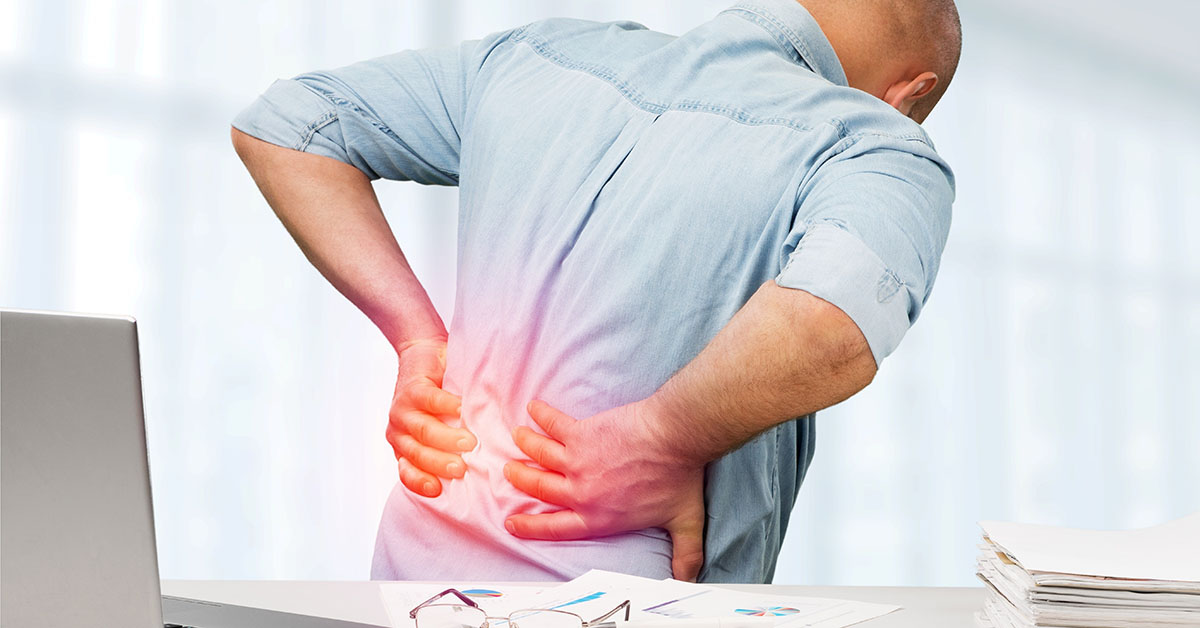
According to the National Institute of Neurological Disorders and Stroke, lower back pain affects up to 80% of the U.S. population at some point in life. Pain in the lower back, or lumbar spine, may be caused by an acute injury or a chronic spine condition.
One of the most common causes of pain in the lumbar spine is age-related degeneration of the bones, discs, ligaments, and muscles of the spine. This is called spinal osteoarthritis and most people over 60 will experience symptoms of osteoarthritis.
However, osteoarthritis isn’t the cause of all back pain. Lower back pain can be caused by any of the conditions described below. Please note that this is not an exhaustive list. If you have pain in your lower back, consult your doctor.
Cause of Pain in the Lower Back
Strains & Sprains
Back injuries like muscle strains or ligament sprains can cause lower back pain. Muscle strains are caused by overstretching the leads to tearing and muscle damage. Strains and sprains of the lower back may develop over time due to repetitive movements, or poor posture. These injuries may also occur suddenly due to movements that put stress on the lower back, including falls or sports injuries.
Lumbar Herniated or Ruptured Disc
The discs between the vertebrae have a jelly-like center called a nucleus contained by a tough outer layer called the annulus. Herniated discs occur when a part of the disc nucleus is pushed out into the spinal canal through a tear in the annulus. The disc presses against the spinal nerves, causing severe pain. Herniated disks are most common in the lumbar spine, or lower back.
Vertebral Compression Fracture
Vertebral compression fractures occur when the bony body of the vertebra collapses. Compression fractures most often occur in the lower vertebrae of the thoracic spine or in the lumbar spine. Spinal compression fractures cause severe back pain and limit mobility. Compression fractures may also lead to a loss in height due to bone collapse.
Sciatica
Sciatica is pain that occurs along the sciatic nerve. The sciatic nerve branches out from the lower back to the hips and buttocks then down the legs. Sciatica may be related to several spinal conditions that compress the sciatic nerve including:
- Spinal stenosis
- Herniated disk
- Bone spur
Sacroiliac Joint Dysfunction
The sacroiliac (SI) joint is a joint near the bottom of the lumbar spine. It connects the hip bones to the sacrum between the spine and tailbone. The function of the SI is shock absorption. A healthy SI joint only moves a little. A dysfunctional joint moves too much or too little.
- Hypermobility/Instability: The joint moves too much, causing the pelvis to feel unstable. Instability causes pain in the lower back and hips.
- Hypomobility/Fixation: The joint does not move enough, which causes muscle tension and limits mobility. Fixation causes lower back pain on one side that may radiate down to the buttocks and leg.
Spinal Tumors
Spinal tumors are growths that develop either within the spinal cord or in the vertebra.
- Tumors in the spinal cord are called intradural tumors and may also affect the protective covering, which is called the dura.
- Intramedullary tumors develop in the cells in the spinal cord itself.
- Extramedullary tumors develop in the membrane surrounding the spinal cord or the nerve roots that branch out from the spinal cord.
- Tumors that affect the bones of the spine, or vertebrae, are called vertebral tumors.
The symptoms produced by spinal tumors can change as the tumors develop and grow. Symptoms also vary depending on the area affected by the tumor. Some symptoms include:
- Back pain that radiates to other parts of the body
- Back pain that worsens at night
- Muscle weakness
- Difficulty walking
- Pain at the site of the tumor
The Importance of Accurate Diagnosis
Getting an accurate diagnosis for the cause of your lower back pain is crucial because the diagnosis dictates what treatment options are available. If you are incorrectly diagnosed and receive the wrong treatment, you won’t experience pain relief and other complications can arise.
That’s why diagnostic imaging tests are so important. But just as important as the scans themselves is the expertise of the radiologist who interprets them to confirm a diagnosis. You need to trust the physician reading your MRI, CT scan, or X-Rays.
If you are experiencing lower back pain and have concerns about your diagnosis, Dr. Saint-Louis of SpineRad can provide you with an expert second opinion based on the scans and reports you already have. Simply update your documents to the SpineRad site and within three days, you will receive a complete report with an explanation of your scan results. You don’t even have to leave the house. Click here to get started.